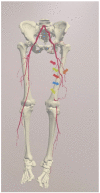The Influence of Individualized Three-Dimensional Holographic Models on Patients' Knowledge Qualified for Intervention in the Treatment of Peripheral Arterial Disease (PAD)
- PMID: 37998522
- PMCID: PMC10671973
- DOI: 10.3390/jcdd10110464
The Influence of Individualized Three-Dimensional Holographic Models on Patients' Knowledge Qualified for Intervention in the Treatment of Peripheral Arterial Disease (PAD)
Abstract
We sought to determine the role of the patient-specific, three-dimensional (3D) holographic vascular model in patient medical knowledge and its influence on obtaining a more conscious informed consent process for percutaneous balloon angioplasty (PTA). Patients with peripheral arterial disease who had been scheduled for PTA were enrolled in the study. Information regarding the primary disease, planned procedure, and informed consent was recorded in typical fashion. Subsequently, the disease and procedure details were presented to the patient, showing the patients their individual model. A patient and medical supervisor equipped with mixed reality headsets could both simultaneously manipulate the hologram using gestures. The holographic 3D model had been created on a scale of 1:1 based on computed tomography scans. The patient's knowledge was tested by the completion of a questionnaire before and after the interaction in a mixed reality environment. Seventy-nine patients manipulated arterial holograms in mixed reality head-mounted devices. Before the 3D holographic artery model interaction, the mean ± standard deviation score of the knowledge test was 2.95 ± 1.21 points. After the presentation, the score had increased to 4.39 ± 0.82, with a statistically significant difference (p = 0.0000) between the two scores. Using a Likert scale from 1 to 5, the patients had scored the use of the 3D holographic model at 3.90 points regarding its usefulness in comprehending their medical condition; at 4.04 points regarding the evaluation of the holograms as helpful in understanding the course of surgery; and rated the model at 1.99 points in reducing procedure-related stress. Using a nominal scale (know or don't know), the patients had self-assessed their knowledge of the procedure before and after the 3D model presentation, with a score of 6.29 ± 2.01 and 8.39 ± 1.54, respectively. The study group tolerated the use of head-mounted devices. Only one patient had nausea and dizziness, while four patients experienced transient eye pain. The 3D holographic arterial model aided in the understanding of patients' knowledge regarding the disease and procedure, making the informed consent process more conscious. The holograms improved the patient's self-consciousness. Mixed reality headset-related complications were rare and within acceptable rates.
Keywords: HoloLens; augmented reality; hologram; informed consent; mixed reality; patient education; percutaneous transluminal angioplasty; peripheral artery disease; surgery preparation.
Conflict of interest statement
The authors declare no conflict of interest.
Figures





Similar articles
-
Augmented Reality with HoloLens® in Parotid Tumor Surgery: A Prospective Feasibility Study.ORL J Otorhinolaryngol Relat Spec. 2021;83(6):439-448. doi: 10.1159/000514640. Epub 2021 Mar 30. ORL J Otorhinolaryngol Relat Spec. 2021. PMID: 33784686
-
Stenting for peripheral artery disease of the lower extremities: an evidence-based analysis.Ont Health Technol Assess Ser. 2010;10(18):1-88. Epub 2010 Sep 1. Ont Health Technol Assess Ser. 2010. PMID: 23074395 Free PMC article.
-
Cinematic Rendering in Mixed-Reality Holograms: A New 3D Preoperative Planning Tool in Pediatric Heart Surgery.Front Cardiovasc Med. 2021 Feb 9;8:633611. doi: 10.3389/fcvm.2021.633611. eCollection 2021. Front Cardiovasc Med. 2021. PMID: 33634174 Free PMC article.
-
A wearable mixed-reality holographic computer for guiding external ventricular drain insertion at the bedside.J Neurosurg. 2018 Oct 16;131(5):1599-1606. doi: 10.3171/2018.4.JNS18124. Print 2019 Nov 1. J Neurosurg. 2018. PMID: 30485188
-
Image Overlay Surgery Based on Augmented Reality: A Systematic Review.Adv Exp Med Biol. 2020;1260:175-195. doi: 10.1007/978-3-030-47483-6_10. Adv Exp Med Biol. 2020. PMID: 33211313
Cited by
-
Technological Advances in Pre-Operative Planning.J Clin Med. 2025 Jul 30;14(15):5385. doi: 10.3390/jcm14155385. J Clin Med. 2025. PMID: 40807006 Free PMC article. Review.
References
-
- Criqui M.H., Matsushita K., Aboyans V., Hess C.N., Hicks C.W., Kwan T.W., McDermott M.M., Misra S., Ujueta F. Lower Extremity Peripheral Artery Disease: Contemporary Epidemiology, Management Gaps, and Future Directions: A Scientific Statement From the American Heart Association. Circulation. 2021;144:e171–e191. doi: 10.1161/CIR.0000000000001005. - DOI - PMC - PubMed
-
- Fowkes F.G.R., Rudan D., Rudan I., Aboyans V., Denenberg J.O., McDermott M.M., Norman P.E., Sampson U.K.A., Williams L.J., Mensah G.A., et al. Comparison of global estimates of prevalence and risk factors for peripheral artery disease in 2000 and 2010: A systematic review and analysis. Lancet. 2013;382:1329–1340. doi: 10.1016/S0140-6736(13)61249-0. - DOI - PubMed
LinkOut - more resources
Full Text Sources

